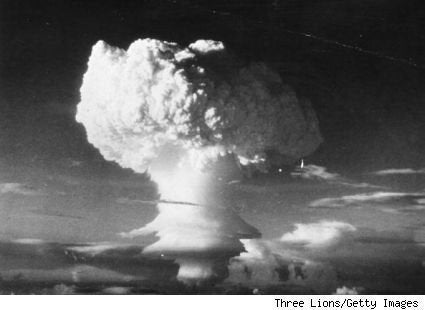
I'm standing where blue sky meets the parched sand of a New Mexico desert, and where physics changed forever the course of international affairs. It's a bright, clear day. There are no clouds, no winds, no disturbances.
The circle of earth I'm standing on -- a few hundred yards across -- is fenced off by barbed wire. Had I been here July 16, 1945 at 5:30 a.m., I would have been incinerated instantly by the 10-million-degree heat from fissioning plutonium atoms. Not today. Flowers grow, mothers hold children, a crew from a Japanese TV network records a documentary.
Some say modern history began on this patch of dirt 120 miles southeast of Albuquerque when the U.S. detonated the first atomic bomb 100 feet above where I'm standing, on a giant steel tower. On my right is what's left of the tower today -- melted tentacles of one of its legs. At my feet are bits of sand scorched so intensely they were fused into the green glass Trinitite.
Twice a year, on the first Saturday of April and October, the U.S. government opens to the public the Trinity Site, also known as New Mexico's "ground zero." There's no need to book a visit. Just turn up at Otero County Fairgrounds in Alamogordo, where a caravan of cars, complete with police escorts, departs early in the morning for the 85-mile trip across the normally restricted White Sands Missile Range.
Trinity was the culmination of the Manhattan Project where, during World War II, some of the best scientific minds toiled for three years at nearby Los Alamos to perfect a device they called "the gadget." With the force of 20,000 tons of TNT, the gadget broke windows 90 miles away.
Dr. Edward Teller, who designed the subsequent hydrogen bomb and whom I interviewed before his death in 2003, was 20 miles away at detonation. "The shot was canceled, then put back on," he told me. "The countdown stopped at minus 30 seconds. An eternity passed and I thought it was a failure, but it was just a very long 30 seconds. When I did see light -- it was before sun-up -- I tipped my welding glass and looked at the sand beside me. It was as daylight."
At 10 a.m., after a two-hour drive through the desert with road signs like "Danger, Unexploded Live Munitions" and "Peligroso! Missile Impact Area," we were suddenly a mile from ground zero ourselves. Before you enter the fenced-in part, there's a tent with Geiger counters.
Radioactivity? "Any out here can be blocked by your skin," a White Sands employee assures us. She says touring ground zero results in about two milliroentgens -- less than the radiation absorbed when you fly from New York to Los Angeles in a jetliner. To prove her point, she points a Geiger counter at display items including some old Fiestaware pottery, a radium clock dial and the rare Trinitite glass. The last item produces the fewest number of clicks.
Inside the fenced-in area there's a mock-up of Fat Man, the plutonium bomb used at Nagasaki. There's also a jet-black obelisk monument, proclaiming the site a national landmark.
Another White Sands employee says she's answered questions of visitors from all over the world -- Japan, Switzerland, Germany, Mexico -- during her years of working at Trinity. "You see lots of World War II vets who think it was a good thing we invented the bomb. But others say they wish the atom was never delved into."
I'm intrigued by the mix of people. Some seem clueless, as if they were bused in from Disney World. Others have a serious, inquisitive look. A Ukrainian metallurgist says he's known about Trinity since childhood. Asked if he feels any irony standing here with an American after decades of nuclear arms buildup during the Cold War, he flatly says no. "It was only political," he smiles. "People are the same everywhere, I think."
At noon, I'm about to join the car caravan for the drive back to Alamogordo. In a part of the circle where nobody else has wandered, I spy a small purple wildflower growing out of the sand. I bend down to inspect it and there, on the desert floor six inches away, are two little pieces of Trinitite, undisturbed and sparkling green in the sun.